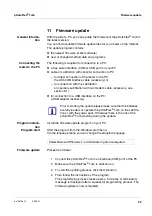
Lists
pHotoFlex
®
Turb
94
ba75976e07
09/2021
Glossary
Adjusting
To manipulate a measuring system so that the relevant value (e.g. the
displayed value) differs as little as possible from the correct value or a
value that is regarded as correct, or that the difference remains within
the tolerance.
Analysis specification
The exact proceeding to carry out the detection procedure is described
in the analysis instructions.
Asymmetry
Designation of the offset potential of a pH electrode. It is the measur-
able potential of a symmetrical electrode, the membrane of which is
immersed in a solution with the pH of the nominal electrode zero point
(WTW electrode pH = 7).
AutoRange
Name of the automatic selection of the measuring range.
AutoRead
WTW name for a function to check the stability of the measured value.
Blank value (reagent
blank value)
The evaluation of the photometric measurement always refers to the
comparison value of a sample without the substance to be determined
(reagent blank value). Thus the influence of the basic absorbance of
the reagents on photometric measurement is compensated for.
Calibration
Comparing the value from a measuring system (e. g. the displayed
value) to the correct value or a value that is regarded as correct. Often,
this expression is also used when the measuring system is adjusted at
the same time (see adjusting).
Cell
Vessel that takes a liquid sample for the photometric measurement.
The cell material (mostly glass) must have certain optical features to
be suitable for photometry.
Citation forms
Different forms of representing a measured concentration value that
can be derived from each other.
The method for determining phosphate provides, for example, a mea-
sured value for phosphorous P. This measured value can also be
quoted in other citation forms such as PO4, PO4-P or P2O5.
Detection procedure
The detection procedure designates the general principle of how a
sample is brought into a form suitable for measurement.
Different methods can be based on the same detection procedure.
Electrode zero point
The zero point of a pH combination electrode is the pH value at which
the electromotive force of the pH combination electrode at a specified
temperature is zero. Normally, this is at 25 °C.
Electromotive force of
an electrode
The electromotive force U of the combination electrode is the measur-
able electromotive force of an electrode in a solution. It equals the sum
of all the galvanic voltages of the combination electrode. Its dependen-
cy on the pH results in the electrode function, which is characterized
by the parameters, slope and zero point.











































